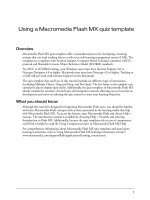Tài liệu Application Overview Power-over-Ethernet docx
Bạn đang xem bản rút gọn của tài liệu. Xem và tải ngay bản đầy đủ của tài liệu tại đây (242.69 KB, 4 trang )
Introduction
Final approval of the Power-over-Ethernet (PoE) standard in June 2003, removed a
significant barrier to widespread adoption of IP telephony. The standard (IEEE 802.3af)
specifies how to supply power to compliant devices over Ethernet LAN cabling. Armed
with uninterruptible power supplies (UPS), IT staff can now deploy Voice over IP (VoIP)
telephones without worrying about them not functioning during a power outage.
The benefits of this enabling technology extend beyond IP telephony. Many
applications that deploy equipment with low power requirements in areas that aren't
already wired for power will benefit from reduced cabling costs. A single standard
Ethernet cable will now be able to provide both power and communication services
to wireless network access points, IP cameras, security badge readers, and many other
devices.
Advantages of PoE include:
•
Reduced cabling costs: One cable provides both power and data.
•
Reliability: A UPS at the power distribution source can guarantee power to all
connected devices.
•
The first worldwide power standard: This means that PoE devices will plug in
anywhere.
•
SNMP network management: This system can be used to monitor and control
connected devices.
•
Simplification of wireless LAN installation: Access points can be moved and
wired in easily.
Application Overview
Power-over-Ethernet
WHITE PAPER
Application Overview: Power-over-Ethernet
Page 2
ADC Midspan Controller
The ADC midspan controller is a rack-mounted, fully
802.3af compliant midspan PSE that can power
between one and 24 PoE devices. It offers the flexibility
of universal input power (115/230VAC, 50/60Hz) and
multiple configurations.
The midspan controller panel's powerful management
features include:
• Full compliance to the IEEE 802.3af standard with
capability to provide 15.4 Watts of power on every
port simultaneously
• Redundant power capability on all designs
• Modular SNMP and Power Supply chasis design,
allowing in-service field upgrades to redundant power
and/or SNMP capability
• SNMP Stacking, allowing up to 5 chassis to be
controlled b a single SNMP card and IP address
• Dual complance to both IEEE 802.3af and Pre-
Standard Cisco in-line powering
When and How to use ADC's Solution
When
1. An IEEE 802.3af powered device such as a VoIP
phone, Wi-Fi access point, network camera, etc.
requires power via the Ethernet cabling
2. Total distance between Ethernet switch and powered
device is 100 meters or less
3. Ethernet switch is not PoE capable
4. Ethernet switch is PoE capable, but cannot deliver the
required power
How
1. Install the midspan PoE controller between the existing
Ethernet switch and the powered device. ADC
recommends installing the midspan PoE controller and
Ethernet switch in the same or adjacent racks.
2. Install standard RJ45 patch cable between the existing
Ethernet switch and the bottom port of midspan PoE
controller.
3. Install standard RJ45 patch cable between the top port
of midspan PoE controller and a standard horizontal
distribution patch panel.
4. Use ANSI/TIA/EIA-568 standard methods to run
horizontal cabling between the distribution patch
panel and the wall outlet and jack in the work area.
5. Install a standard RJ45 patch cord between the wall
outlet jack and the powered device at the work area.
Installation
The diagram above shows a typical installation with
ADC's PoE solution. 10/100Base-T data is routed via
a standard RJ45 cable from the Ethernet switch to the
midspan PoE controller. The PoE controller injects power
into the unused pairs if an 802.3af compliant device is
detected on the remote end. The power plus data is
routed from the PoE controller to a standard RJ45 patch
panel for distribution to the work area. It is important
to use appropriate cable management and installation
practices to route these cables as critical voice and data
traffic is being transmitted over the Ethernet cables.
Ethernet Distribution Frame
In Telecommunications Room (TR)
Work Area (WA)
IP desk phone
Powered Device (PD)
Power Required
Workstation
PoE Power
Not Needed
To Work Area (WA)
without PoE
Power-over-Ethernet
Midspan Controller
Horizontal
Cross-Connect (HC)
To PD in
Work Area (WA)
Requiring PoE
Horizontal
Cabling
Application Overview: Power-over-Ethernet
Page 3
Frequently Asked Questions
Q: If I run Power-over-Ethernet to a computer, will I
damage the NIC?
A: No, ADC has designed the Power-over-Ethernet
controller to sense if the remote powered device is
IEEE 802.3af compliant. If the powered device is not
designed to accept power, the controller will not send
power.
Q: What is PoE's distance limitation of power?
A: Power-over-Ethernet is limited by the distance that
standard Ethernet can run, which is 100 meters
between Ethernet switch and powered device.
IMPORTANT NOTE: The midspan PoE controller
is passive to the Ethernet signal, and does not
regenerate the signal. The distance limitation
from the Ethernet switch to the powered device is
100 meters regardless of where the midspan PoE
controller is located in the network.
Q: Can I run 1000Base-T through the midspan PoE
controller?
A: No, the PoE controller is currently only designed
to work with 10/100Base-T Ethernet. The IEEE
802.3af document only defines Power-over-Ethernet
for 10/100Base-T and not for Gigabit Ethernet.
Furthermore, all available powered devices are also
10/100Base-T.
Q: I'm using a Cisco device that is line power capable,
but was introduced before the IEEE 802.3af standard
was released, can I power it with your midspan PoE
controller?
A: Yes, although certain Cisco devices such as the
7960 IP Phone and some Aironet Access Points use
a Pre-Standard in-line powering scheme, ADC has
designed all of our Midspan devices to detect both
IEEE 802.3af and Pre-Standard Cisco devices and
send the appropriate power, all from the same device,
without any special installation gear, techniques, or
configurations.
Q: How much power is being run over the Ethernet
cable, and is it safe?
A: The IEEE 802.3af document defines five classifications
of power depending on the device; ADC's solution
covers this full range, which calls for a maximum
of 15.4 Watts on each and every powered port.
Accounting for the resistance in the cable, the
powered device can draw up to 12.95 Watts of
power at the remote end. Although this is potentially
a lot of power, remember that the ADC design senses
if the remote device will accept power, and if not, will
not send any power.
Q: Which pins on the RJ45 are powered?
A: Midspan devices power on pins 4,5 and 7,8, the
unused pairs in 10/100Base-T. This allows the data
to pass through unaffected (i.e. if power is removed
from the PoE chassis, the data is unaffected).
Q: Can I manage the PoE Controller via software?
A: Yes, ADC has an optional SNMP controller card that
can be installed into our standard chassis. This allows
you to manage and monitor the PoE controller. Our
design also allows you to daisy-chain up to five
PoE controllers together and manage them with
one SNMP card and one IP address, simplifying the
management and reducing the cost of the solution.
Q: How can I find out if ADC's PoE controller will work
with my VoIP phone or Wi-Fi access point?
A: ADC's controller will work with any IEEE 802.3af
compliant device as well as Pre-Standard Cisco in-line
powered devices. Check the technical specifications
of your device for IEEE 802.3af compliance. The IEEE
specification has been released since June 2003, so
most manufacturers are compliant. If you are unsure,
please contact ADC's technical assistance center. We
would be happy to assist you in determining the best
solution for your needs.
Q: Do I need to run new RJ45 cables from the midspan
controller to the switch or to the powered device?
A: No. The midspan controller uses existing cabling,
since both the power and Ethernet signals are fed
through the same cable.
Q: How do I know if power is fed through the RJ45
cable?
A: An LED on the front of the panel indicates whether
or not the power is injected though the cable. Also,
querying the CPU card both locally and remotely will
provide you with the power status of each port.
Web Site: www.adc.com
From North America, Call Toll Free: 1-800-366-3891 • Outside of North America: +1-952-938-8080
Fax: +1-952-917-3237 • For a listing of ADC’s global sales office locations, please refer to our web site.
ADC Telecommunications, Inc., P.O. Box 1101, Minneapolis, Minnesota USA 55440-1101
Specifications published here are current as of the date of publication of this document. Because we are continuously
improving our products, ADC reserves the right to change specifications without prior notice. At any time, you may
verify product specifications by contacting our headquarters office in Minneapolis. ADC Telecommunications, Inc.
views its patent portfolio as an important corporate asset and vigorously enforces its patents. Products orfeatures
contained herein may be covered by one or more U.S. or foreign patents. An Equal Opportunity Employer
102260AE 3/06 Revision © 2004, 2006 ADC Telecommunications, Inc. All Rights Reserved
WHITE PAPER









